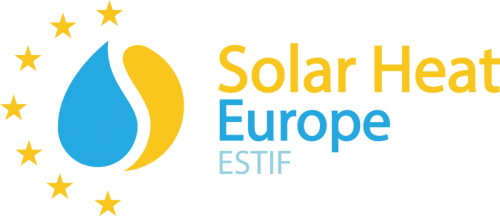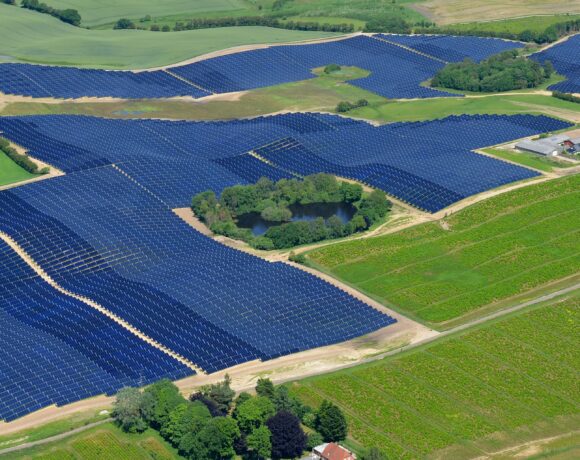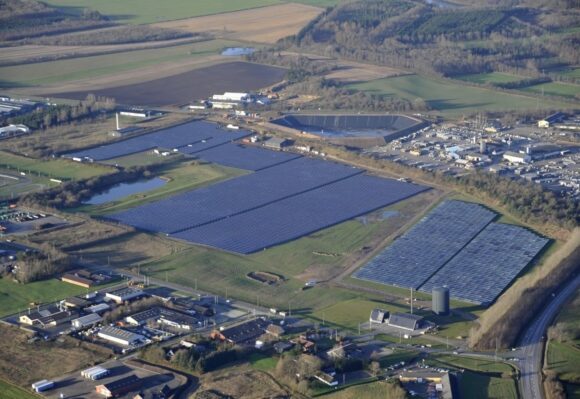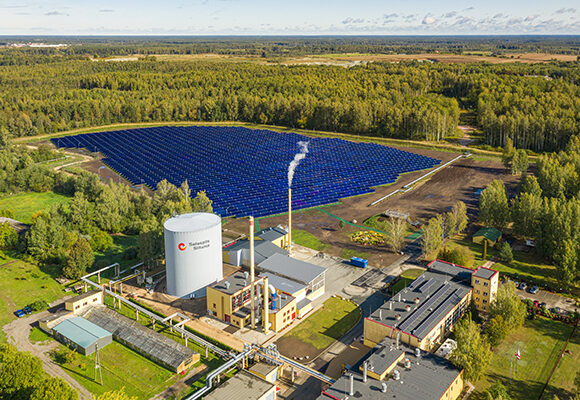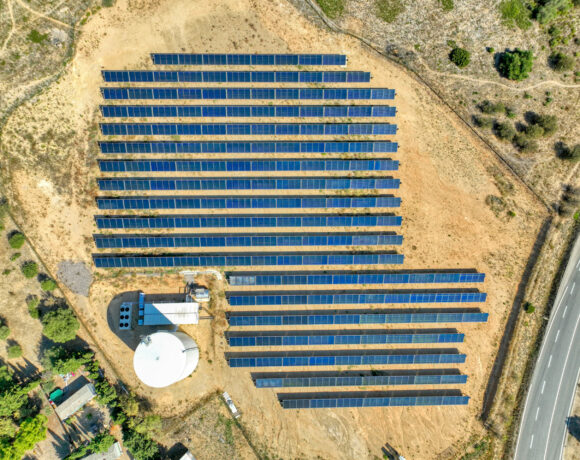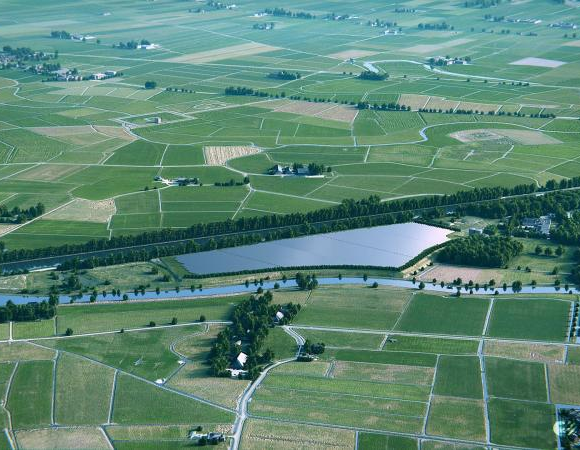Solar District Heating
About the application
Solar District Heating (SDH) systems use solar thermal technology to produce hot water for district heating networks, reducing reliance on fossil fuels and contributing to decarbonisation efforts in communities and cities. Well-established in Europe, particularly in Northern countries like Denmark, SDH holds significant potential to further decarbonise heat across diverse regions.
Currently, several large SDH systems are under construction in different countries, including Germany, the Netherlands, Serbia, and Kosovo. These initiatives are a testimony of the increasing adoption of solar thermal technology, marking important steps towards heating decarbonisation across Europe.
Description of use
Heating and cooling account for half of Europe’s energy consumption, a significant portion of which is used in the form of hot water or space heating in buildings. This demand can be met through different systems, like individual boilers or centralised networks like district heating.
District heating is a network providing heat, usually in the form of hot water. This heat serves space heating and domestic hot water needs, and in some cases, covers certain industrial heat demand too. The main advantage of these systems is that they are more efficient, more economic and create less pollution than decentralised fossil fuel-based boilers. The heat generated in a centralised manner is then distributed to urban areas through a system of pipelines specially designed for transporting heat, which is then supplied to each house.
Integrating large solar thermal plants into local district heating networks ensures a clean and renewable heat supply to these networks. During warmer periods, they can entirely replace other sources, usually fossil fuels, used for heating. Thanks to the developments in large scale thermal storage, it is also possible to store heat in summer for winter use. Solar heat can also meet a share of the heating demand during winter.
Benefits
The benefits of solar thermal systems, in particular for such large systems, cover environmental, political and economic aspects.
Environmental benefits relate to the capacity to reduce harmful emissions. The reduction of CO2 emissions depends on the quantity of fossil fuels replaced directly or indirectly when the system replaces the use of carbon-based electricity used for water heating. Depending on the location, a 1.4 MWth (2000 m²) system could generate the equivalent of 1.1 GWh/year, a saving of around 200 tonnes of CO2.
Political and economic benefits are associated with the potential savings in energy costs and the possibility of improving energy security by reducing energy imports while creating local jobs related to the manufacturing, commercialization, installation, and maintenance of solar thermal systems. Notably, most Solar District Heating systems in Europe use solar collectors produced locally, boosting the European economy and creating green jobs.
Regarding energy costs and potential savings, there are three main aspects to consider that have a bigger impact on the comparable costs of the energy produced by a solar thermal system. These are the initial cost of the system, the lifetime of the system, and the system’s performance. These factors depend on the location (affecting climate, insulation, taxes, cost of living, etc.) and quality of the system (affecting performance, lifetime, and cost). This can vary significantly from country to country. Therefore, average investment costs for solar thermal systems can vary greatly from country to country and between different systems.
Even though SDH systems require higher upfront costs, they offer economic advantages in the longer term. SDH systems ensure price stability for at least 20 years. Analysis of existing systems demonstrates that solar heat is economically competitive, even in comparison to gas, as seen during Europe’s recent energy crisis. For instance, in a 110 MW plant, the levelised cost of solar heat varies between 18 and 33 EUR/MWh over 25 years, highlighting both its cost-effectiveness and sustainability.
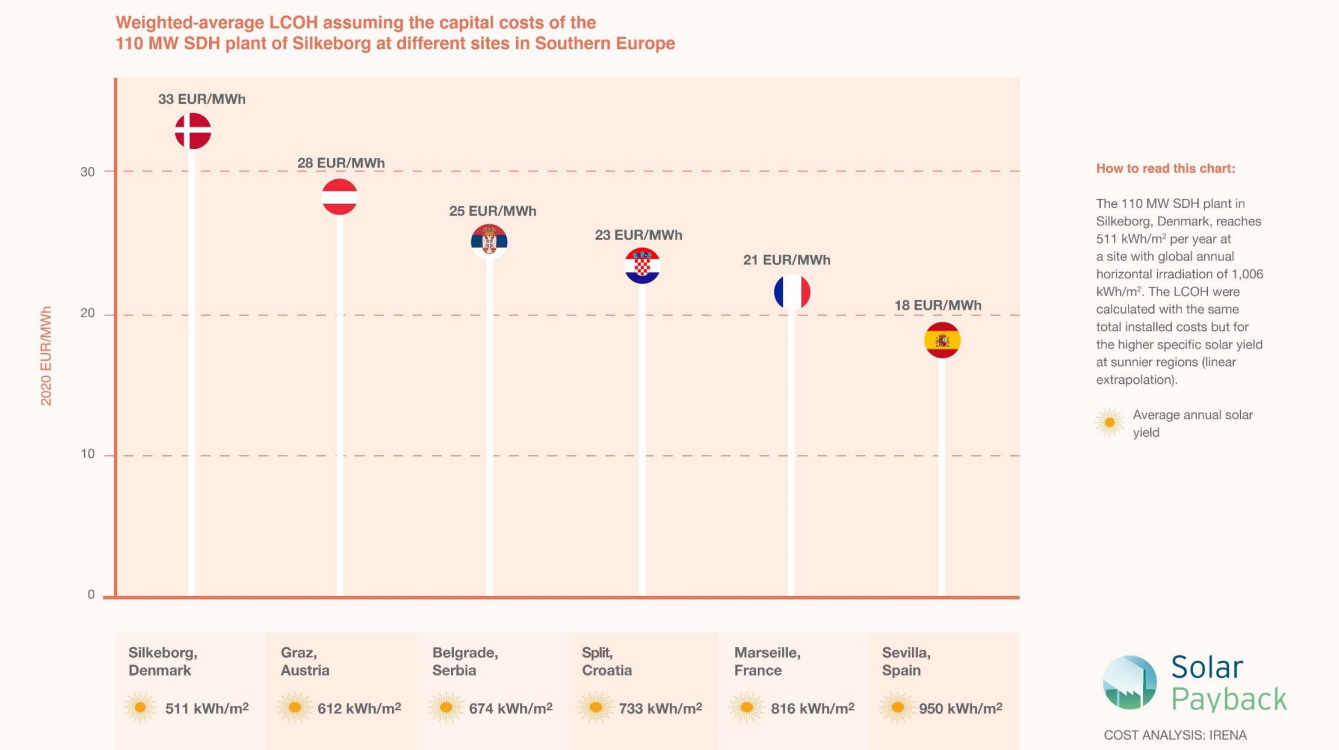
Worldwide applicability
SDH systems are applicable wherever district heating networks exist, often found in cold climates with high heat demand during autumn and winter. Despite initial assumptions, the feasibility and competitiveness of using solar thermal energy in such climates have been proven. Europe leads the way, with 80% of the total Solar District Heating networks worldwide located on the continent.
Currently, 282 European towns and cities have embraced Solar District Heating, showcasing its effectiveness. Key adopters include Sweden, Denmark, Germany, and Austria, with Denmark leading the way by setting impressive world records. The economic and environmental benefits of SDH systems, supported by decades of technical expertise, facilitate the increased adoption and drive their commercial success.
*The map below was last updated when the number of towns and cities using SDH was 264.
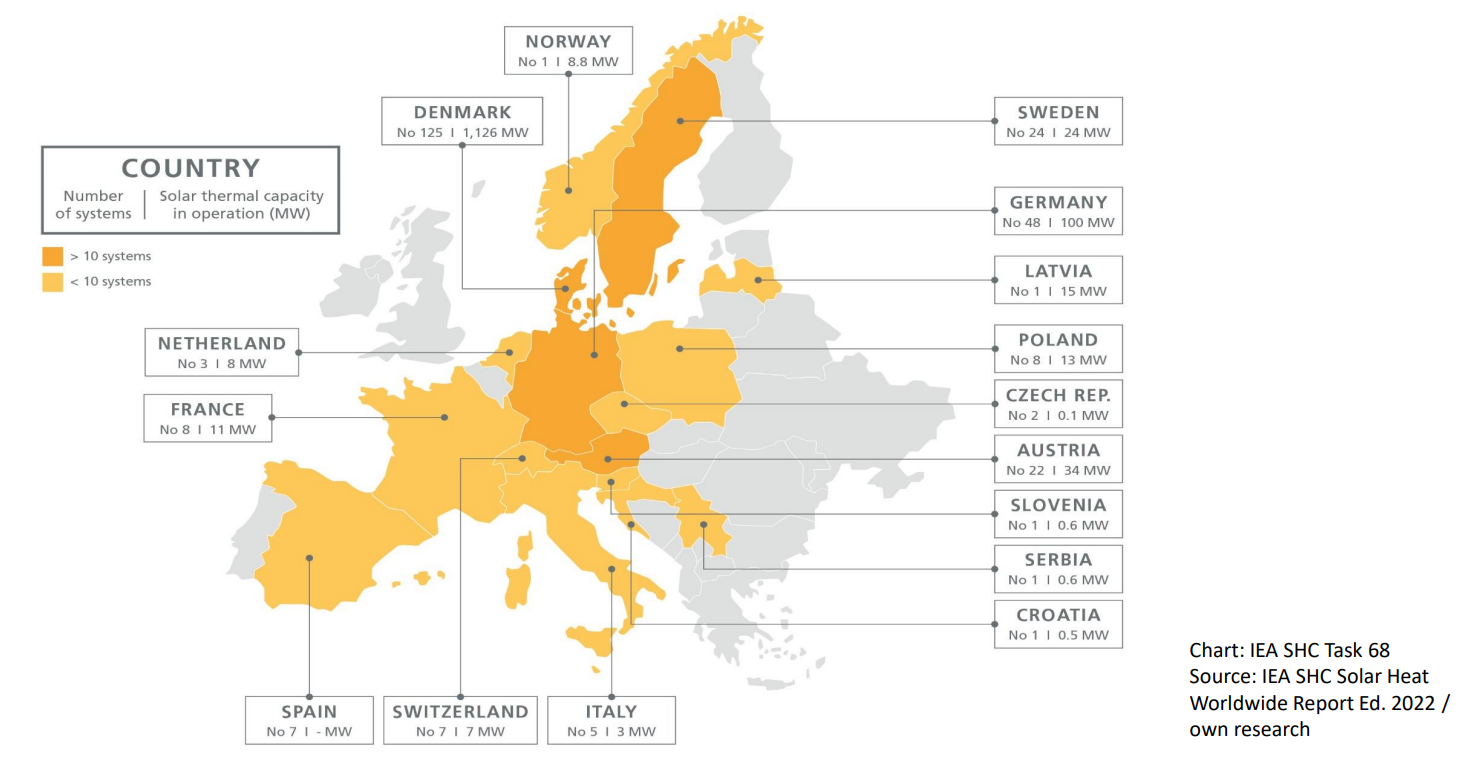
Examples of Solar District Heating plants across Europe
Silkeborg, Denmark

Largest solar district heating plant in the world
- Location: Silkeborg, Denmark
- Power Peak: 110 MWth
- Households supplied: 22 000
- Solar Collectors Area: 156 694 m²
- Commissioned: December 2016
- Annual Energy Delivery: Approximately 80 000 MWh per year
- CO2 Emissions Avoided: Approximately 15 000 tonnes per year
- Type of collector/supplier: flat plate collectors by Arcon Sunmark – Trade of GREENoneTEC
- Project Developer: Arcon Sunmark – Trade of GREENoneTEC
In the Danish city of Silkeborg, with 44,000 inhabitants, the world’s largest solar thermal plant was installed in 2016. The 12,436 large collectors are mounted on agricultural areas in front of the city’s gate. Solar heat in district heating complements classic gas-driven cogeneration plants. The collector field delivers 80,000 MWh yearly and has a nominal power of 110 Megawatts. It covers 20% of the heat demand in the district heating network of Silkeborg and the complete summer load.
The plant does not include seasonal thermal energy storage, despite its dimensions. This results in particularly low heat costs and is facilitated by the size of the city of Silkeborg, which has a high enough summer load to utilize all the solar heat directly when produced.
Besides gas and solar thermal energy, wind electricity is expected to supply an increasing portion of the heat in the district heating network of Silkeborg.
Vojens, Denmark

Solar district heating with the largest pit thermal storage globally
- Location: Vojens, Denmark
- Power Peak: 49 MWth
- Households supplied: 2 000
- Solar Collectors Area: 70 000 m²
- Storage capacity: 200 000 m³
- Commissioned: 2016
- CO2 Emissions Avoided: Approximately 6 000 tonnes per year
- Type of collector/supplier: flat plate collectors by Arcon Sunmark – Trade of GREENoneTEC
- Project Developer: Arcon Sunmark – Trade of GREENoneTEC
In Vojens, Denmark, known for its less sunny climate, the world’s largest seasonal solar heat storage project has been operational since 2016. This extensive storage functions as a seasonal heat storage, enabling the solar heating plant, which is the third largest in the world, to contribute over 50% of the annual heat production to the network.
The remaining heat is generated by three gas engines, a 10 MW electric boiler, an absorption heat pump, and gas boilers.
Groningen, Netherlands

Fourth-largest solar district heating plant globally in the making
- Location: Groningen, Netherlands
- Power Peak: 37 MWth
- Output temperature: 69 – 93 °C
- Households supplied: 10 000
- Solar Collectors Area: 48 000 m²
- Storage capacity: 6 000 m³
- Planned date for commissioning: early 2024
- Land Area: 12 hectares (including technical building and storage tank)
- Annual Energy Delivery: 25 000 MWh yearly
- CO2 Emissions Avoided: Approximately 6 000 tonnes per year
- Type of collector/supplier: High-Vacuum Flat Plate manufactured by TVP Solar
- Project Developer: Novar
The 48,000 m2 solar thermal collector field will be connected to the district heating grid of Groningen, which is operated by the utility company Warmtestad. Three companies joined forces to develop this ambitious project: Novar (NL), as the project developer, K3 (NL), as the investor, and TVP Solar (CH), as the turnkey provider of the solar field. Together they founded a special purpose vehicle (SPV) – an entity that owns and operates the plant.
The solar thermal plant supports the ambition of the municipality of Groningen to be energy-neutral by 2035. Once completed, the solar heat will cover 25 % of the total heat demand for private and public buildings in the northwest of Groningen.
The EUR 23 million CAPEX was partly made available by a loan from the Triodos Bank. The project SPV, as the owner of the solar heat plant, will also receive a feed-in tariff from the national subsidy scheme called SDE++. It supports energy produced over 15 years using a wide range of renewable technologies including solar thermal. The feed-in tariff is calculated as the difference between the current gas price and a price cap of 85 EUR/MWh. This difference is updated annually and paid over a period of 15 years.
Furthermore, the project SPV has signed a long-term solar heat delivery contract over 30 years with the utility Warmtestad.
Högslätten, Sweden

Solar district heating using concentrating solar thermal technology
- Location: Högslätten, Sweden
- Power Peak: 1.5 MWth
- Output temperature: 73 – 120 °C
- Solar Collectors Area: 3 000 m²
- Commissioned: 2023
- Land Area: 1 hectare
- Annual Energy Delivery: 1 000 MWh yearly
- Type of collector/supplier: Concentrated Solar Collector Absolicon T160
- Project Developer: Absolicon
In 2020, Absolicon initiated the construction of the pilot project, Högslätten 2023 Solar Thermal Park, representing Sweden’s largest solar field integrated with district heating using concentrating solar collectors. Situated close to Absolicon’s headquarters in Härnösand, Sweden, the solar thermal field delivers heat with a working temperature ranging from 73°C to 120°C, directly feeding into the city district heating network.
The solar heat generated in the park is marketed through a heat purchase agreement (HPA) with the local district heating supplier. Independent validation of the plant’s performance and system benefits is conducted by third-party entities, including the Research Institute of Sweden (RISE) and Umeå University.
In collaboration with the local energy company HEMAB, Absolicon has implemented two installations in the company’s energy park, one linked to the return line and another featuring a steam generating system connected to the supply pipe.
Acknowledging the significance of the project, the Swedish Energy Agency granted €800,000 in May 2020, co-financing the large-scale solar heating plant by Absolicon.
The park’s construction was executed in two phases, with the initial phase completed in the summer of 2021 and the final phase concluded by the end of 2023.
Narbonne, France

Second largest solar district heating plant in France
- Location: Narbonne, France
- Power Peak: 2.8 MWth
- Households supplied: 9 000 (+7 schools and several public buildings)
- Solar Collectors Area: 3 232 m²
- Storage capacity: 1 000 m³
- Commissioned: September 2021
- Annual Energy Delivery: Approximately 2 200 MWh per year
- CO2 Emissions Avoided: Approximately 600 tonnes per year
- Type of collector/supplier: Flat Plate Collectors manufactured by Meriaura Energy / Savosolar
- Project Developer: Newheat
The second-largest solar district heating plant in France supplies renewable heat to the city of Narbonne’s heating network. The district heating network serves various structures, including social housing and buildings in Narbonne city.
The core principle of this solar thermal integration involves heating the network through end-of-network integration, resulting in significant fossil fuel savings, particularly in gas consumption.
Additionally, the system optimizes the biomass boiler functionality in winter through the pooling of the storage tank.
The project developer, Newheat, owns the plant and sells the thermal energy to the City of Narbonne through a Heat Purchase Agreement signed for a duration of 25 years.
Geneva, Switzerland
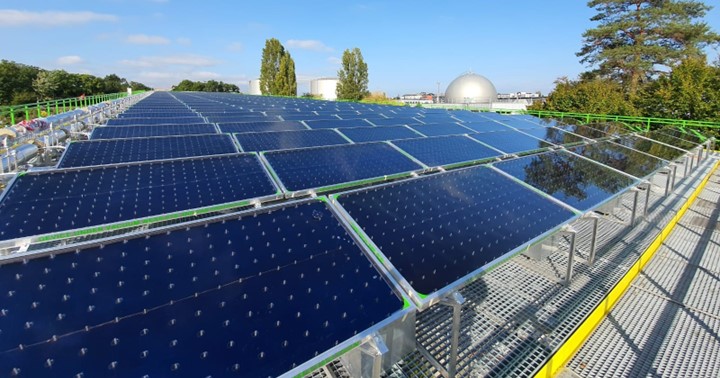
Rooftop solar district heating plant
- Location: Geneva, Switzerland
- Output temperature: 75 – 90 °C
- Solar Collectors Area: 784 m²
- Commissioned: December 2020
- Annual Energy Delivery: Approximately 558 MWh per year (exceeding initial estimations)
- CO2 Emissions Avoided: Approximately 115 tonnes per year
- Type of collector/supplier: High-Vacuum Flat Plate manufactured by TVP Solar
- Project Developer: TVP Solar
TVP Solar and the Geneva utility SIG published the performance results of the SolarCAD II – Solar District Heating Plant after 2 years in operation. The thermal plant has exceeded expectations by delivering 10% over the estimates and the results are key to duplicating the model across Switzerland and beyond.
The TVP flat plate vacuum collectors supplied 100% carbon-free thermal energy at more than 80°C year-round, even in winter, directly injecting the heat into the largest district heating network in the canton, the CAD SIG, to which more than 60,000 households are connected. At the time of its installation, the 800 m² plant was expected to have an injected solar production of more than 0.5 GWh per year.
Outperforming original estimations of the system’s efficiency is not the only positive aspect of the pilot project analysis. Monitoring the project allowed TVP to measure the ease of operation of the system, which thanks to a fully automated and remotely accessible operation, the Solar District Heating plant required little human intervention and no cleaning since its installation.
In addition to solar thermal input, the district heating network benefits from energy derived from an incineration plant, CHP plants, gas boilers, biomass boilers, and geothermal sources.
Bad Rappenau, Germany
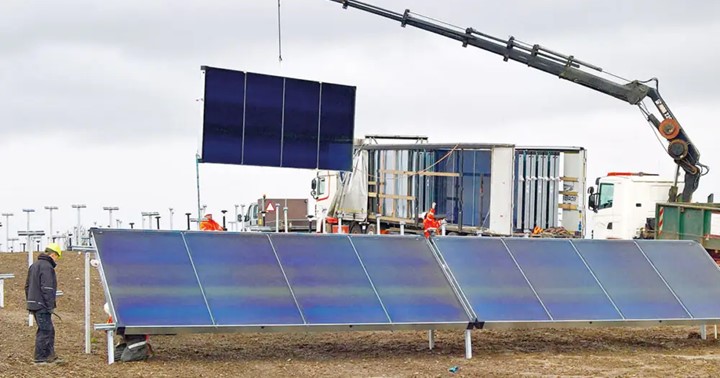
Large solar district heating in the making in Southern Germany
- Location: Bad Rappenau, Germany
- Power Peak: 20 MWth
- Solar Collectors Area: 29 000 m²
- Planned date of commissioning: 2024
- Land Area: 6 hectares
- Annual Energy Delivery Estimation: Approximately 13 GWh per year
- Type of collector/supplier: Flat Plate Collectors manufactured by Meriaura Energy/Savosolar
This large-scale solar district heating plant, announced earlier this year, is set to start operations in 2024. It aims not only to meet the entire hot water demand for connected households in the village of Bad Rappenau in southern Germany during the summer but also to facilitate the drying of animal feed at the factory owned by the investor, Bauer Biomasse. The company’s motivation, as stated by Markus Bauer, the company boss, is that wood and, particularly, biogas are too valuable to be used for generating district heat when solar energy can fulfill that purpose.
Graz, Austria
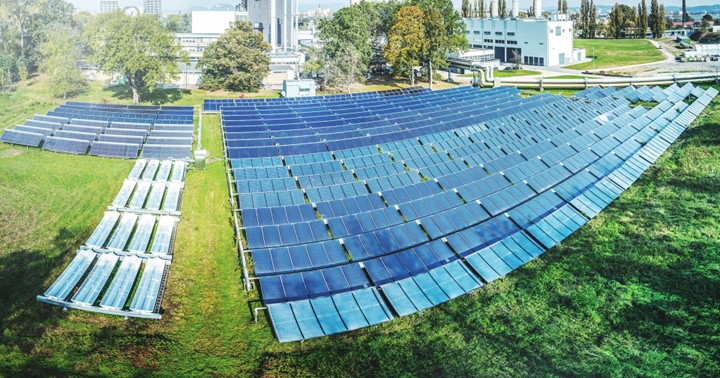
Solar district heating as the world′s largest field test for solar collectors
- Location: Graz, Austria
- Power Peak: 3.5 MWth
- Solar Collectors Area: 8 213 m²
- Commissioned: 2007
- CO2 Emissions Avoided: Approximately 740 tonnes per year
- Project Developer: SOLID
This solar district heating plant in Graz represents the world’s largest field test for solar thermal collectors.
Energie Steiermark’s central District Heating plant supplies a significant portion of the City’s District Heating needs, with a peak load of 550 MW and an annual demand of approximately 1200 GWh to the town and surrounding villages. Originally, the district heating supply was primarily sourced from combined heat and power (CHP) during winter and gas heating plants during summer.
In 2007, a 3.5 MW (5000 m²) solar thermal installation was initiated on the roofs of the municipal recycling center. Subsequently, additional areas near the heating plant became available, leading to the establishment of a comprehensive collector field for district heating feed-in, testing, and comparison. This field featured collectors from seven different manufacturers, employing various technologies, which underwent rigorous testing and evaluation through research and development projects.
Owned by the solar energy service company solar.nahwärme, the project sells heat to Energie Steiermark. It plays a pivotal role in the city and utility’s joint efforts to enhance the environmental sustainability of the district heating supply. Future plans include a substantial increase in the solar thermal share within Graz’s district heating network.
Salaspils, Latvia

Solar thermal and biomass for a 90% renewable district heating
- Location: Salaspils, Latvia
- Power Peak: 15 MWth
- Households supplied: 17 000
- Solar Collectors Area: 21 672 m²
- Storage capacity: 8 000 m³
- Commissioned: 2019
- Annual Energy Delivery Estimation: Approximately 12 GWh per year
- Type of collector/supplier: flat plate collectors by Arcon Sunmark – Trade of GREENoneTEC
- Project Developer: Filter
In 2019, district heating operator Salaspils Siltums inaugurated a 21,672 m² solar field and a wood chip boiler, put up in the middle of the woods near the town of Salaspils, Latvia, to meet 90 % of the demand from the local district heating network.
Salaspils Siltums started planning the solar system after a neighbouring cogeneration plant was shut down. Ina Berzina-Veita, Managing Director of Salaspils Siltums, shared insights into the project’s inception at the moment of the inauguration, stating, “We embarked on this journey after attending the solar district heating conference in Billund, Denmark, in 2016, held under the H2020 Project SDHp2m. Our goal was clear: to reduce our carbon footprint and diminish reliance on fossil fuels.” Following a comprehensive feasibility study in January 2017, the utility successfully secured EU funding in February of the same year.
The EU’s Cohesion Fund has contributed EUR 2.73 million to the EUR 7.08 million invested in the solar field, the storage tank and the 3 MW biomass boiler.
Pancevo, Serbia
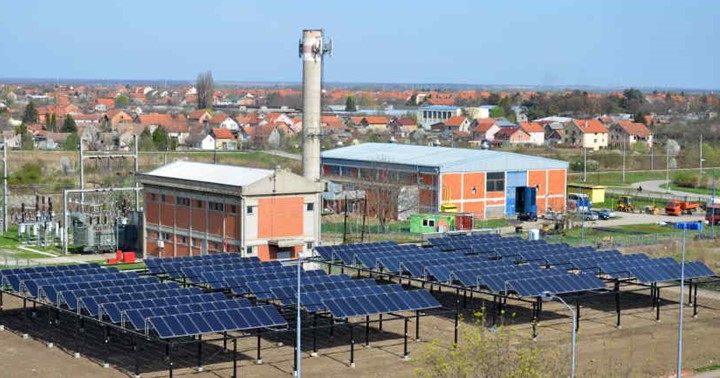
Demonstrated success leading to expansion of Balkan solar plant
- Location: Pancevo, Serbia
- Power Peak: 1 MWth
- Commissioned: First phase in 2017; Second phase in 2020
- Annual Energy Delivery Estimation: Approximately 900 MWh per year
- CO2 Emissions Avoided: Approximately 200 tonnes per year
The solar thermal plant currently fulfills 15% of the total demand for hot sanitary water in Pancevo. With support from EBRD and SOLID, the local utility plans to further expand the solar field to encompass 35,000 m² of collector area and include a thermal storage unit of 150,000 m³. The BigSolar Pancevo project has the potential to be a flagship initiative in Western Balkan countries, contributing significantly to CO2 reduction in district heating.
The solar district heating in Pancevo was initially built in 2017 with 360 solar thermal collectors, boasting a total installed capacity of 700 kWth and an annual production of 600 MWh. The money came from the EU’s IPA funds as part of cross-border cooperation between Serbia and Romania. The thermal collectors were placed over 906 square meters of land.
The system was expanded in March 2020, in cooperation with USAID, when a further 198 thermal collectors were added, boosting the total capacity to slightly over 1 MWth and the projected annual output to 900 MWh. It is now the largest solar thermal system in the Balkans. The total investment is estimated at EUR 600,000. With an operational lifespan of 25-30 years and minimal operating costs, the cost of hot water is now lower than that of natural gas, the company’s primary fuel.
The solar thermal plant currently fulfills 15% of the total demand for hot sanitary water in Pancevo. With support from EBRD and SOLID, the local utility plans to further expand the solar field to encompass 35,000 m² of collector area and include a thermal storage unit of 150,000 m³. The BigSolar Pancevo project has the potential to be a flagship initiative in Western Balkan countries, contributing significantly to CO2 reduction in district heating.
Technical information
SDH systems consist of solar thermal plants, made up of hundreds of solar thermal collectors. Considering the requirements of such large systems, larger collectors working with bigger loads have been designed specifically for such applications. For smaller systems (block heating), normal solar thermal collectors, either flat plate, evacuated tube or even concentrating, can be used.
These solar thermal plants supply heat to a district heating network. It can consist of a centralized supply, where a very large collector field delivers heat to a main heating central. It can also provide, directly or indirectly, a large seasonal heat store that will contribute to increasing the input of solar thermal plants to the whole system.
The other possible configuration is a decentralised supply or distributed solar district heating. In this case, solar collectors are placed at suitable locations (buildings, parking lots, small fields) and connected directly to the district heating primary circuit on site. This solution can also be interesting for smaller district heating networks or block heating networks. A system is considered large when it is over 350 kWth (500 m²) but solar district heating systems can reach sizes 300 times bigger, i.e. over 100 MWth.
Temperature: between 40 and 100 degrees
40°C to 100°C temperature is the typical usage of solar thermal systems. The temperature requirements highly depend on the currently used temperature in the grid and just follow the demand.
Control: Advanced controls and metering, remote monitoring.
Solar district heating systems require advanced control and metering because an adequate control strategy in place is paramount for improving the performance of the system. This control is usually done remotely.
Operation & Maintenance: Low
The operating and maintenance requirements are in line with operating such large systems, either solar thermal or using other technologies. Correct operation is also required to maximize performance.
Additional resources
Introduction to Solar District Heating by IEA-SHC Task 68
This presentation shows how solar district heating works and who is using it successfully already.
IEA-SHC Task 68 – Efficient Solar District Heating Systems
The purpose of the Task is to investigate how to increase the efficiency of SDH systems.
Solar District Heating Platform (EU Project – Horizon 2020)
These EU Projects aimed to support the market rollout of solar district heating in Europe.
